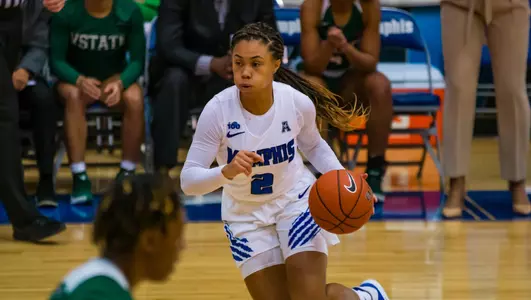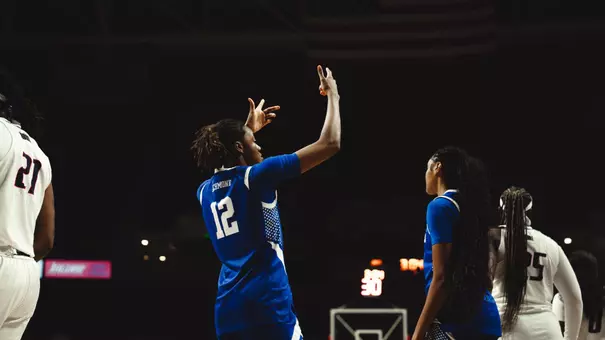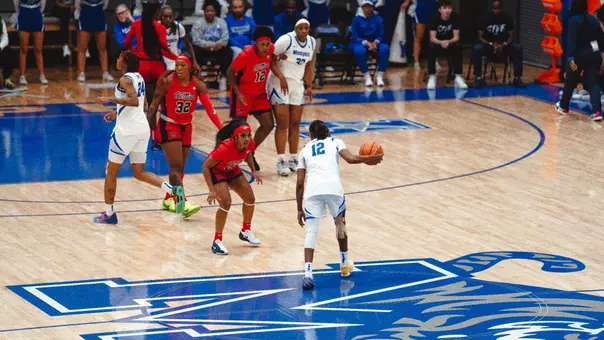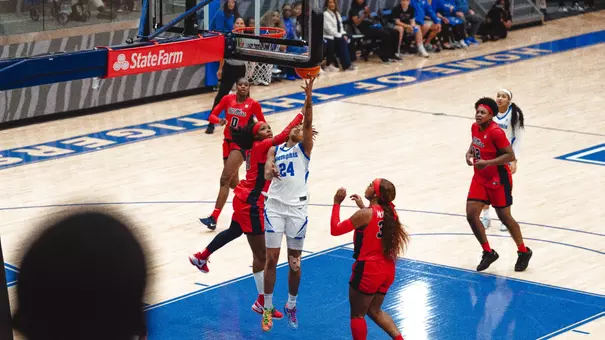University of Memphis Athletics

Photo by: Matthew A. Smith
Women's basketball gets a leg up on training
Jul 08, 2020 | Women's Basketball
UofM's Human Performance Center looks to reduce knee injuries
MEMPHIS, Tenn. – The study began with a simple question from the University of Memphis women's basketball staff, a query whose answer could positively impact the program.
Women's coach Melissa McFerrin presented the question to Dr. Daniel Greenwood, the UofM's Human Performance Center Director. McFerrin wanted to know how to "better prepare our athletes so we are not dealing with ACL injuries."
In Dr. Greenwood, McFerrin found an individual more than capable of finding a solution. In fact, Dr. Greenwood's work with the women's basketball program was among 20 projects with Tigers athletics covering a 15-month period where the Human Performance Center collaborated with coaches to improve on-field, on-court, on-course and on-track performances.
McFerrin said Dr. Greenwood and his staff assessed the players in an attempt to determine where they were deficient and where they were at risk.
"Effectively, (Dr. Greenwood) told us why our athletes were at risk, how they were at risk and how to correct it," McFerrin said. "After the summer (of 2019) testing and going into the fall, he created a program that basically improved or eliminated those deficiencies."
McFerrin's question was one those involved in women's athletics have sought an answer to for years.
According to Beacon Orthopaedics and Sports Medicine, female athletes are five times more likely to sustain a non-contact ACL injury than their male counterparts. The reasons are varied, from the physical (smaller ACLs, wider pelvises and more elastic ligaments) to the technical (women tend to run upright, have flat-footed landings and possess stronger quadriceps than hamstrings).
McFerrin thought Dr. Greenwood's intervention was "incredibly successful" despite one player – Jamirah Shutes -- suffering an ACL injury.
"Regardless," McFerrin said. "Accidents do happen. (Shutes) stepped on someone's foot."
Dr. Greenwood's approach was to find a way for McFerrin to keep the majority of her roster available, health-wise, for a season.
"We started at a position of a healthy athlete being a fundamental challenge in women's basketball," Dr. Greenwood said. "The season before they ended up with only six or seven players remaining (on the roster) by the end of the season.
"The first challenge posed was: Can we get our team healthier for the next season? When you look at basketball (based on all the data collected through the years) the biggest risk factor is lower-limb injuries and in women's basketball it's the ACL, which is the main ligament in your knee."
Dr. Greenwood said women are more susceptible to those types of injuries "because of the way their bodies are structured with their hips being wider than men's hips."
"Their knees are naturally set farther apart and therefore at greater danger buckling inwards," he said.
The challenge, Dr. Greenwood said, was to screen, and understand, the things that contribute to the ACL injuries.
He began by addressing four areas: body mass; sleep; hamstring and quadriceps strength; and the players' mechanics hopping on one and two legs. Body mass was measured, a questionnaire on sleep was distributed, hamstrings and quadriceps were assessed and how players landed on one and two legs was observed.
The approach was slightly different from what Dr. Greenwood was accustomed. He had been involved in player rehab, but this project involved a twist.
"I'd never been involved from the prevention (of such an injury) right from the start, so it was an enjoyable challenge to work on," Dr. Greenwood said. "The fact that players bought into it – and really enjoyed the hopping tasks and the landing tasks that we put into their warm-ups – made them feel we had done something to contribute to not only their performance, but their health and their long-term health."
Dr. Greenwood said he drew upon the vast wealth of information from colleagues – physiotherapists and doctors back in his native Australia and those working with him at Memphis -- who had dealt with this type of injury in basketball, soccer, hockey and field sports that require a similar change of direction. He said the nature of a basketball game, where multiple players can get entangled, on occasion, leaping for a rebound and landing in a congested area, creates opportunities for leg injuries.
In addition to Max Paquette and Alex Carnall from the UofM Human Performance Center, the research also was aided, coincidentally, by having one of the nation's leading ACL researchers from High Point (N.C.) University – Jeff Taylor -- move to Memphis. Taylor has been chair of the University of Tennessee Health Science Center since August 2019.
"We ended up getting him on board to help us with the programming as well," Greenwood said. "He had done a lot of work in that rehab space as well.
"One of the reasons he moved to Memphis was because of the work we were starting to do at the University of Memphis. (Taylor) wanted to help athletes, rather than just write papers on how to make things better. So a wide net was cast to try and find answers."
What their research found was unlike in tennis, where an athlete plans his movement, basketball players frequently jump only to land among a collection of feet below them. Occasionally they are landing on one foot, while getting knocked sideways.
"The players have to be extra prepared to land on one leg, in a weird way, yet in a safe way, which is why they need that hamstring to be strong, they need the hamstring and quadriceps to work in coordination to keep that leg stable, " Greenwood said. "And they need to know how to bend that knee if they need to. They have to have their body mass (at an acceptable measure) so there's less weight contributing to force going through that leg as they land. They need the build and the skills to know how to land. It's a skill like anything else."
Greenwood and his staff had six minutes allotted to them daily to work with the players. They spent the limited time doing a series of conditioning exercises, among them: double-leg hops and land; single-leg hops and land; jumps diagonally, jumps backward, jumps forward, and jumps sideways on single legs.
"They were practicing moving their legs with their bodies, which naturally shifts the body and keeps (the athlete) safer," Greenwood said.
McFerrin considered Greenwood's work a success and will employ his services again this season. Greenwood also thought his staff's work had an impact. He noted only one major ACL injury last season, adding "everyone else's lower limbs were pretty much healthy all year."
"This is injury reduction, not injury prevention," he said.
The players enjoyed the program and learning more about how to make themselves healthier for the rigors of a basketball season. Maddie Griggs, who set the school record (96) for 3-pointers in a season, was particularly receptive.
She said she endured knee issues before coming to the UofM.
"I was more stable because we did more exercises to build muscle around our knees," Griggs said. "I learned it was very important to take care of your body, especially at this level. And we learned you have to sleep good and keep hydrated."
"Daniel will always say: `Give me a question that you want the answer to and I'll set up a testing system to give you the answer.'
As for the 96 treys (more than any men's or women's player have made in a single season), Griggs wouldn't go so far as to give Greenwood and his staff credit for her long-range accuracy.
"Oh no," she said. "That was all me."
Women's coach Melissa McFerrin presented the question to Dr. Daniel Greenwood, the UofM's Human Performance Center Director. McFerrin wanted to know how to "better prepare our athletes so we are not dealing with ACL injuries."
In Dr. Greenwood, McFerrin found an individual more than capable of finding a solution. In fact, Dr. Greenwood's work with the women's basketball program was among 20 projects with Tigers athletics covering a 15-month period where the Human Performance Center collaborated with coaches to improve on-field, on-court, on-course and on-track performances.
McFerrin said Dr. Greenwood and his staff assessed the players in an attempt to determine where they were deficient and where they were at risk.
"Effectively, (Dr. Greenwood) told us why our athletes were at risk, how they were at risk and how to correct it," McFerrin said. "After the summer (of 2019) testing and going into the fall, he created a program that basically improved or eliminated those deficiencies."
McFerrin's question was one those involved in women's athletics have sought an answer to for years.
According to Beacon Orthopaedics and Sports Medicine, female athletes are five times more likely to sustain a non-contact ACL injury than their male counterparts. The reasons are varied, from the physical (smaller ACLs, wider pelvises and more elastic ligaments) to the technical (women tend to run upright, have flat-footed landings and possess stronger quadriceps than hamstrings).
McFerrin thought Dr. Greenwood's intervention was "incredibly successful" despite one player – Jamirah Shutes -- suffering an ACL injury.
"Regardless," McFerrin said. "Accidents do happen. (Shutes) stepped on someone's foot."
Dr. Greenwood's approach was to find a way for McFerrin to keep the majority of her roster available, health-wise, for a season.
"We started at a position of a healthy athlete being a fundamental challenge in women's basketball," Dr. Greenwood said. "The season before they ended up with only six or seven players remaining (on the roster) by the end of the season.
"The first challenge posed was: Can we get our team healthier for the next season? When you look at basketball (based on all the data collected through the years) the biggest risk factor is lower-limb injuries and in women's basketball it's the ACL, which is the main ligament in your knee."
Dr. Greenwood said women are more susceptible to those types of injuries "because of the way their bodies are structured with their hips being wider than men's hips."
"Their knees are naturally set farther apart and therefore at greater danger buckling inwards," he said.
The challenge, Dr. Greenwood said, was to screen, and understand, the things that contribute to the ACL injuries.
He began by addressing four areas: body mass; sleep; hamstring and quadriceps strength; and the players' mechanics hopping on one and two legs. Body mass was measured, a questionnaire on sleep was distributed, hamstrings and quadriceps were assessed and how players landed on one and two legs was observed.
The approach was slightly different from what Dr. Greenwood was accustomed. He had been involved in player rehab, but this project involved a twist.
"I'd never been involved from the prevention (of such an injury) right from the start, so it was an enjoyable challenge to work on," Dr. Greenwood said. "The fact that players bought into it – and really enjoyed the hopping tasks and the landing tasks that we put into their warm-ups – made them feel we had done something to contribute to not only their performance, but their health and their long-term health."
Dr. Greenwood said he drew upon the vast wealth of information from colleagues – physiotherapists and doctors back in his native Australia and those working with him at Memphis -- who had dealt with this type of injury in basketball, soccer, hockey and field sports that require a similar change of direction. He said the nature of a basketball game, where multiple players can get entangled, on occasion, leaping for a rebound and landing in a congested area, creates opportunities for leg injuries.
In addition to Max Paquette and Alex Carnall from the UofM Human Performance Center, the research also was aided, coincidentally, by having one of the nation's leading ACL researchers from High Point (N.C.) University – Jeff Taylor -- move to Memphis. Taylor has been chair of the University of Tennessee Health Science Center since August 2019.
"We ended up getting him on board to help us with the programming as well," Greenwood said. "He had done a lot of work in that rehab space as well.
"One of the reasons he moved to Memphis was because of the work we were starting to do at the University of Memphis. (Taylor) wanted to help athletes, rather than just write papers on how to make things better. So a wide net was cast to try and find answers."
What their research found was unlike in tennis, where an athlete plans his movement, basketball players frequently jump only to land among a collection of feet below them. Occasionally they are landing on one foot, while getting knocked sideways.
"The players have to be extra prepared to land on one leg, in a weird way, yet in a safe way, which is why they need that hamstring to be strong, they need the hamstring and quadriceps to work in coordination to keep that leg stable, " Greenwood said. "And they need to know how to bend that knee if they need to. They have to have their body mass (at an acceptable measure) so there's less weight contributing to force going through that leg as they land. They need the build and the skills to know how to land. It's a skill like anything else."
Greenwood and his staff had six minutes allotted to them daily to work with the players. They spent the limited time doing a series of conditioning exercises, among them: double-leg hops and land; single-leg hops and land; jumps diagonally, jumps backward, jumps forward, and jumps sideways on single legs.
"They were practicing moving their legs with their bodies, which naturally shifts the body and keeps (the athlete) safer," Greenwood said.
McFerrin considered Greenwood's work a success and will employ his services again this season. Greenwood also thought his staff's work had an impact. He noted only one major ACL injury last season, adding "everyone else's lower limbs were pretty much healthy all year."
"This is injury reduction, not injury prevention," he said.
The players enjoyed the program and learning more about how to make themselves healthier for the rigors of a basketball season. Maddie Griggs, who set the school record (96) for 3-pointers in a season, was particularly receptive.
She said she endured knee issues before coming to the UofM.
"I was more stable because we did more exercises to build muscle around our knees," Griggs said. "I learned it was very important to take care of your body, especially at this level. And we learned you have to sleep good and keep hydrated."
"Daniel will always say: `Give me a question that you want the answer to and I'll set up a testing system to give you the answer.'
As for the 96 treys (more than any men's or women's player have made in a single season), Griggs wouldn't go so far as to give Greenwood and his staff credit for her long-range accuracy.
"Oh no," she said. "That was all me."
Players Mentioned
Women's Basketball: Alex Simmons SJU Post Game-November 29, 2025
Saturday, November 29
Women's Basketball: Alex Simmons Florida Post Game-November 28, 2025
Saturday, November 29
Women's Basketball: Alex Simmons Post-Game Comments-November 25, 2025
Wednesday, November 26
Women's Basketball: Alex Simmons Post-Game ETSU-November 22, 2025
Sunday, November 23





